Special Report:
SINGAPORE – A HIGH-DENSITY CITY WITH SPORTING CHARACTERS
Chapter 5: Recreational and Public Cycling
Recreational cycling is fairly popular in Singapore. The latest available survey on sports participation indicates that almost 4 per cent of Singapore residents cycle at least once a week (this figure includes leisure cycling in park land and waterfront areas, mountain-biking and road cycling). In particular, young Singapore residents living in the eastern parts of the city enjoy riding their own or rented bicycles on the available good-quality bicycle path in the East Coast Park. For sporty residents who are enthusiastic about mountain-biking, there are notable designated trails in the Bukit Timah Nature Reserve and the Kent Ridge Park.
Over the past few years city-road-cycling has become increasingly popular with the well-to-do local professionals and Caucasian expatriates, emulating the trend observed in other English-speaking cities such as London, Melbourne, Sydney or Auckland, just to name a few. In Singapore the weekend morning is the preferred time of the week to go for longer bike rides, as calmer road traffic reduces the risk of collision with motor vehicles and lessens the exposure to hazardous exhaust fumes.
The Upper Thomson Rd and Mandai Rd are among the most favourite road cycling routes, offering fairly smooth bike rides around the Central Water Catchment. The other popular route is the Changi loop (Changi Coast Rd and Loyang Avenue), which encircles the Changi International Airport; with relatively few traffic lights disrupting the rhythm, it is considered one of the smoothest routes in this high-density city.
On weekdays, on the other hand, strenuous long-distance bicycle commuting in sports gear is trendy among a relatively small number of high-income Singaporeans and expatriates. In particular, middle-aged professionals who reside in the eastern coastal districts, such as Marine Parade or Siglap, and who work in the Central Business District appear to be attracted to the lifestyle concept of commuting independently while, at the same time, boosting their physical fitness. These so-called ‘active commuters’ (a popular term in academic circles) mostly choose to cycle on the 15km-long high-quality bike path, which connects the East Coast Park with the inner city area via the Marina Bridge.
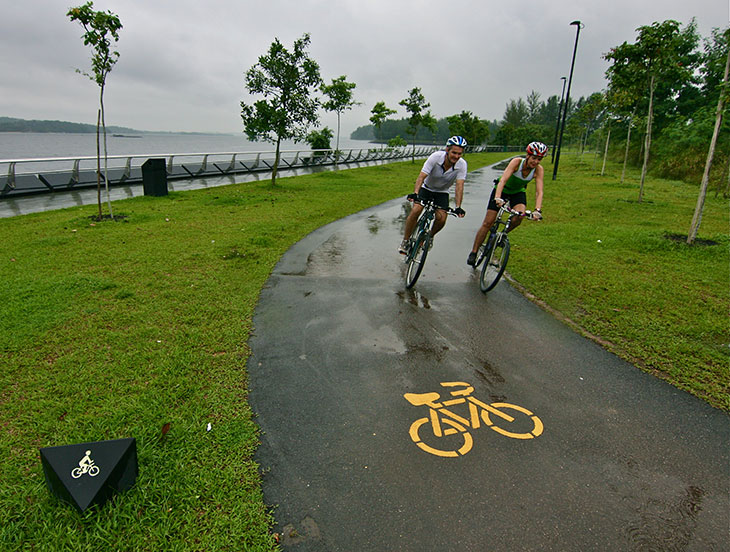
The Punggol Promenade Park Connector. In Singapore Caucasian expatriates are particularly keen on recreational cycling.
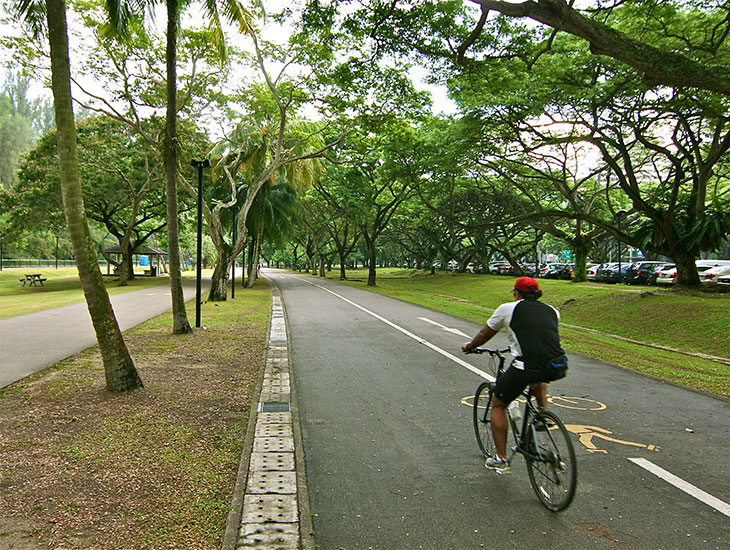
The East Coast Park bicycle trail along Singapore’s south-eastern shore is the preferred choice for local recreational cyclists and bicycle commuters riding to the CBD.
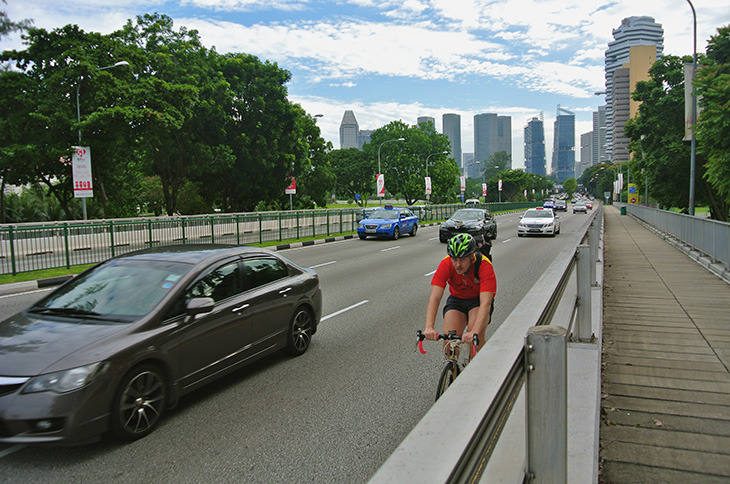
Long-distance bike commuting on busy main roads – such as the Nicoll Highway – is most popular with Caucasian expatriates living in affluent eastern and western districts.
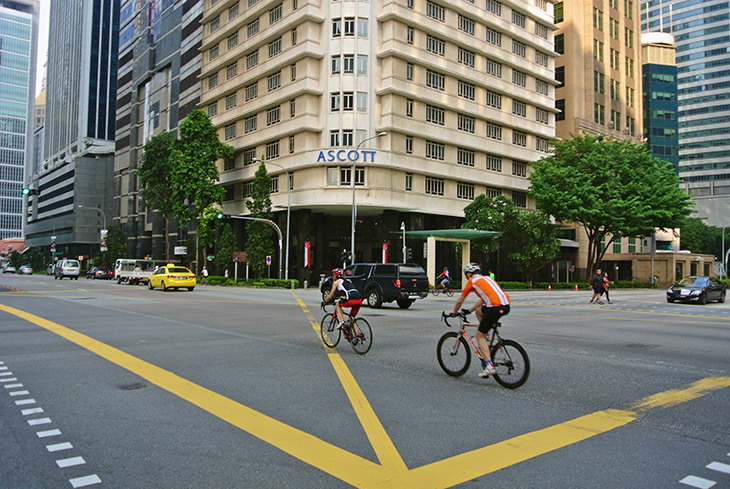
On weekend mornings recreational road cyclists take advantage of low levels of motorized traffic across central districts.
A visitor to Singapore may be forgiven for assuming that long distance bicycle commuting is incompatible with the hot and humid climate prevailing all-year round. As the morning air temperatures usually exceed 25°C and the humidity levels typically range between 80 and 90%, in Singapore a long-distance bike ride to work always makes for a very sweaty morning commute (for more information on climate conditions in Singapore, please read the chapter ‘ “No choice” – Sporting in Tropical Climate’). Hence, commuters choosing to use this ‘active’ transportation mode have to rely largely on their employers’ space generosity, that is, provision of shower facilities at workplace is a key criterion for long-distance bicycle commuting in Singapore; utilising shower facilities at one of the numerous commercial health and fitness clubs located in the CBD also offers a viable alternative for sweaty bike commuters.
It is unclear how many local workers actually choose to commute longer distances by bike, as the Land Transport Authority (LTA) does not provide any official details on bicycle commuting. Yet, at a guess, the proportion of residents cycling longer distances to and from work hovers somewhere between 0.1 and 0.5 per cent (based on qualitative observation on the ground during peak hours). These are rather negligibly low levels. And no sudden boom in long-distance bicycle commuting should be expected in the years to come, as the large majority of local commuters will most likely continue to opt for the reliable air-conditioned public transport system or the more comfortable private vehicles. To increase the numbers of short-distance bicycle trips, the government intends to roll out an extensive bicycle network for all HDB-districts by 2030, according to the government’s latest LTA annual report. This ‘Green Transport’ initiative of providing off-road bicycle lanes within the residential areas would undoubtedly improve accessibility to nearby shopping areas, train stations as well as sporting facilities. By laying out such intra-district bicycle lane networks – similar to the recently completed network of pedestrian-bicycle-shared sections observed in the outer eastern districts of Tampines or Pasir Ris – Singapore’s urban planning strategy would furthermore offer recreational cyclists better access to park connectors – which are typically located between large residential clusters.
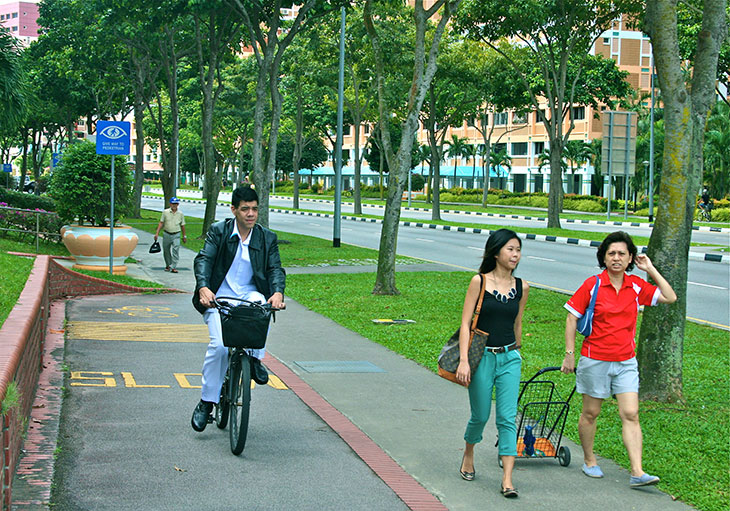
A local public cyclists riding on a typical off-road bicycle lane in Pasir Ris. Bicycle infrastructure has of late become a more common urban planning feature in some parts of the outer districts of Singapore.
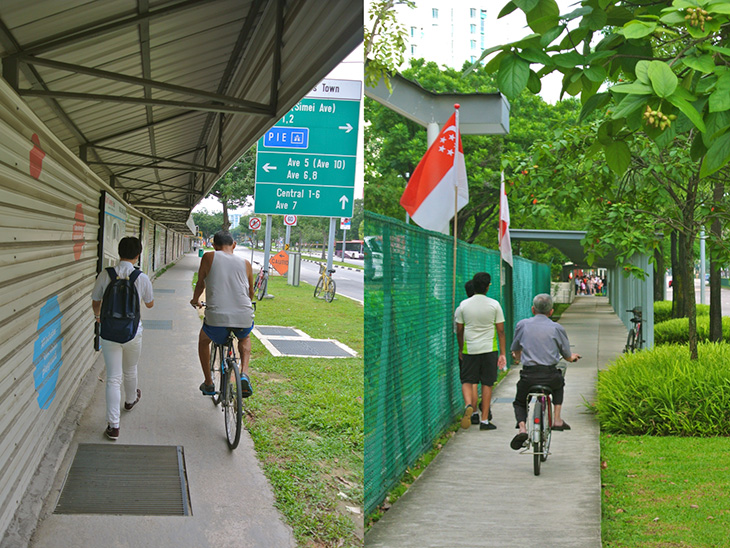
In most residential areas, however, public cyclists and pedestrians typically share the pavement.
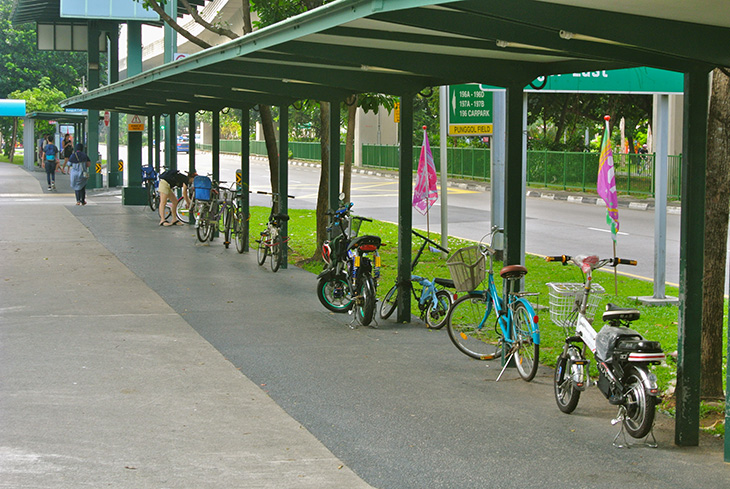
The lack of bicycle parking racks does not deter local residents from public cycling. At popular locations the bikes are usually orderly parked on the side of the pavement.
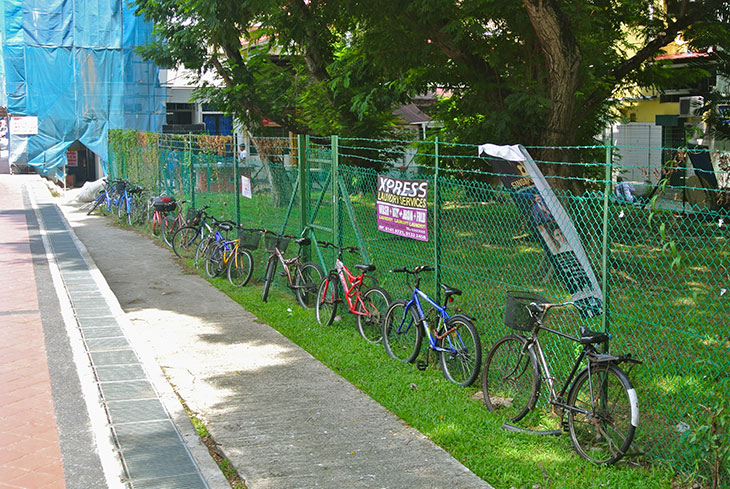
And bicycle parking along wire fences, such as in the older district of Little India, is also fairly common in Singapore.
Nevertheless, it is not clear whether such an ambitious expansion of off-road bicycle lanes would actually result in greater demand. While there is some anecdotal evidence of rising bicycle commuting popularity levels in the western and eastern outskirts of the city, such as in Tampines, Pasir Ris or Jurong West, these bicycle trips are, by and large, limited to short-distance rides to the nearby train stations (No official data could be found that demonstrate any significant increases in bicycle commuting shares). Although it is true that, due to increasing demand, in the past decade more bicycle parking racks have had to be installed around numerous train stations, the plausible reasons for this recent surge in short-distance public cycling are threefold. First, within the last 10 years alone Singapore’s population has risen from 4.2 million to 5.5 million (!). Second, the growing popularity of public cycling appears to be largely attributed to foreign workers of low-income status (these city-dwellers, the so-called ‘non-residents’, are part of the migrant workforce, which accounts for nearly 30% of the city’s total population; yet they remain, by and large, excluded from most official figures on Singapore) (for more information on Singapore’s population and this particular topic, please read the chapter ‘Sporting Affordability for All !?). And third, the non-docking bicycle-sharing technology has also reached Singapore’s HDB-districts – currently, the two most successful companies operating in Singapore appear to be Mobike and oBike. Since 2016 various China-based rental bike companies have been competing against each other for a new customer base in predominantly Chinese cities. It remains to be seen, however, whether this novel way of public cycling can be established as a popular transportation choice across Singapore’s residential districts (for more information, see the illustrative report on ‘Beijing Bicycle Lifestyle – the Game-Changing Expansion of Non-Docking Bicycle-Sharing Schemes’).
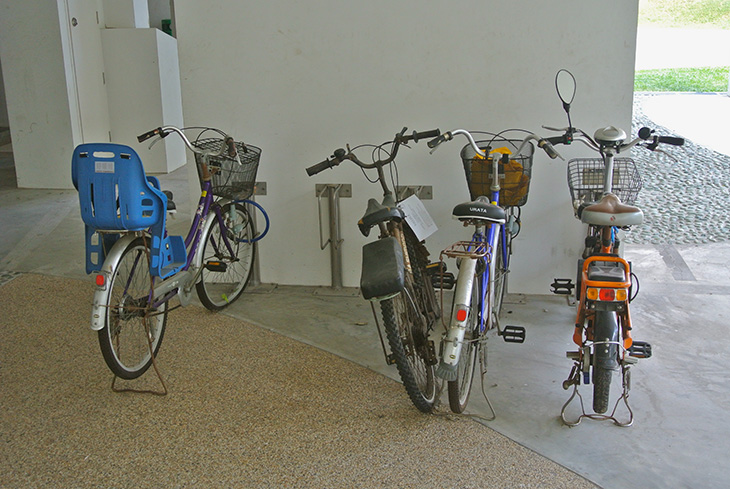
The preferred choice! Low-cost, small-size bikes are popular with residents living in HDB-public housing estates. They are typically used for short-distance rides to local shops or to nearby train stations.
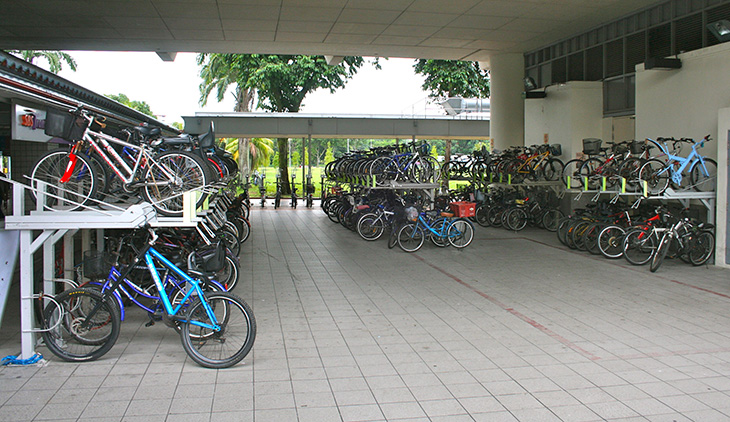
A bicycle parking area at the train station in Pasir Ris. In the outer eastern, northern and western districts the number of low-income Singapore residents, foreign workers and school kids choosing to cycle to the nearby train stations appears to have increased over the past decade.
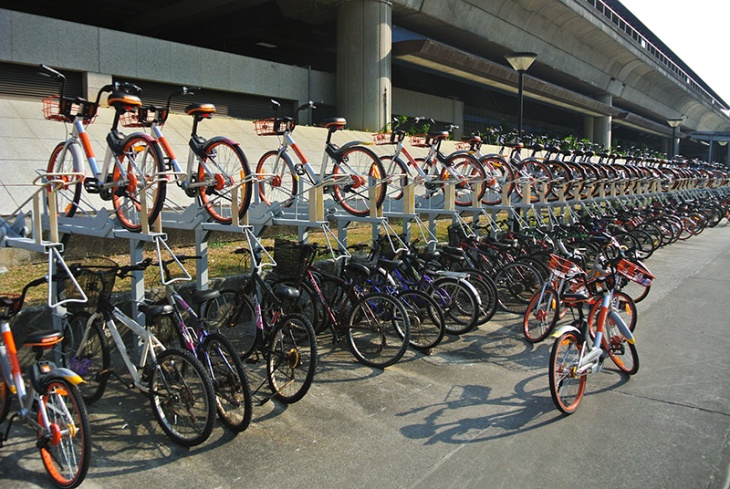
The Mobike bicycle-sharing company positions its bikes of orange colour conveniently at the busy Bedok train station.
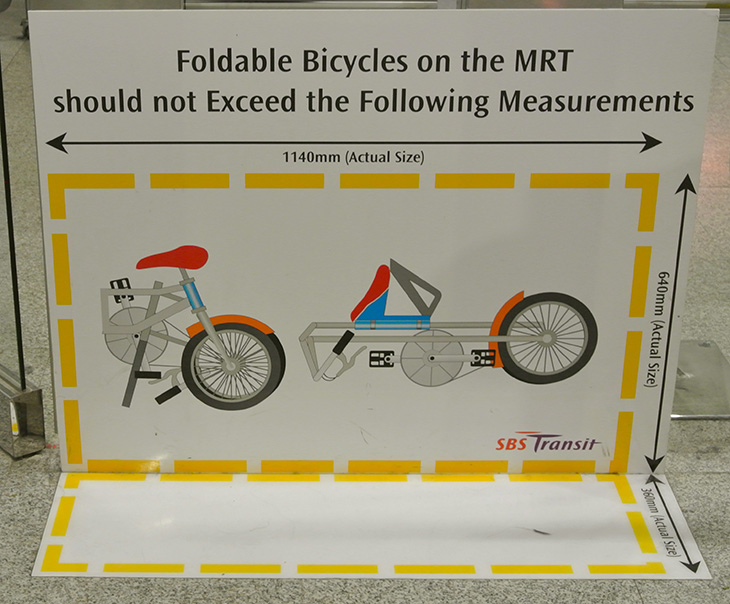
Due to large passenger numbers only folding bicycles are allowed to be brought on metro trains.
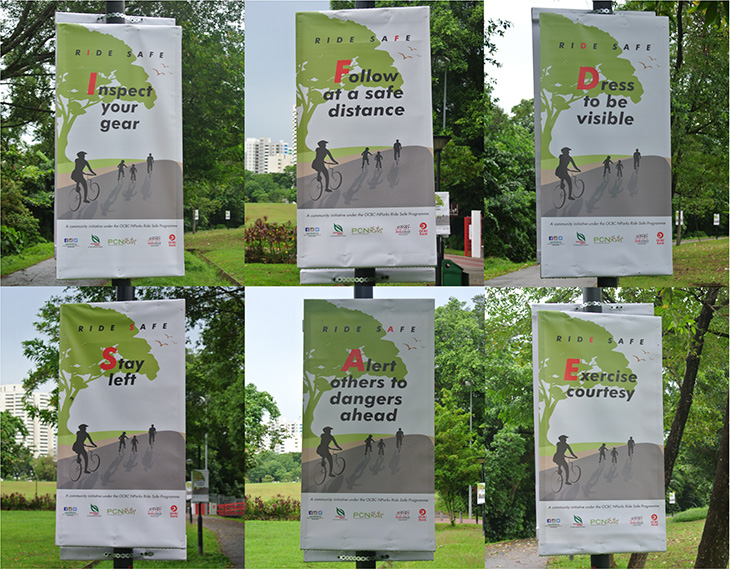
In Singapore public awareness campaigns are omnipresent.
In the inner-city areas, too, a new type of short-distance public cyclists has been noticed. Young local adults, typically linked to the local creative industry, occasionally zip on their swanky and costly Tokyo bikes between locations of interests – which are largely concentrated around the heritage areas, such as Kampong Glam (also known as Arab Street), Ann Siang Hill and Tiong Bahru in Chinatown and Jalan Besar in Little India. Yet this geographically-insulated group of trendy bike commuting enthusiasts, who could also be loosely associated with the global hipster culture, has a rather marginal socio-cultural and numerical impact on the overall bicycle popularity levels in Singapore.
Given the rapid emergence of new disruptive urban technologies, sustainable energy sources and autonomous transportation systems, there is also some level of uncertainty about the future of bicycle commuting in Singapore. With more variety of efficient, air-conditioned and effortless commuting choices being offered to city-dwellers in the not-too-distant future, bicycle commuting (not recreational cycling, though) could possibly become obsolete and eventually vanish as a viable transportation option.
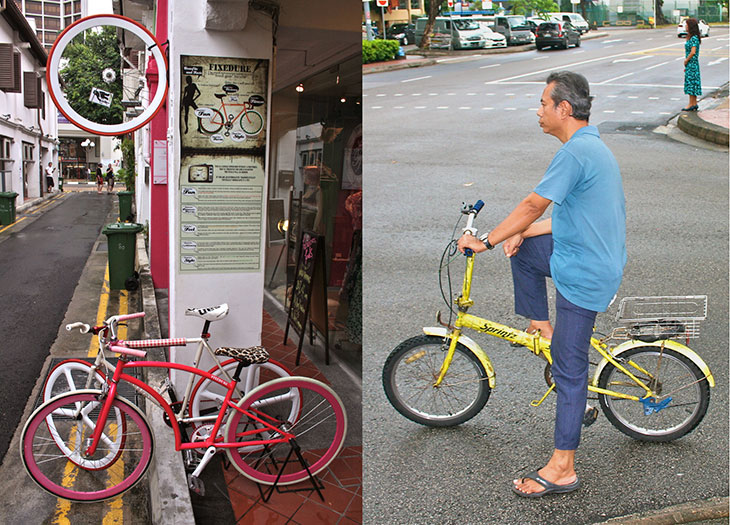
Riding a swanky Tokyo Bike is now very fashionable among the affluent Millennials (left Photo). In contrast, the old generation of Singaporeans still sticks to the 1960s European-style folding bicycles (right photo).
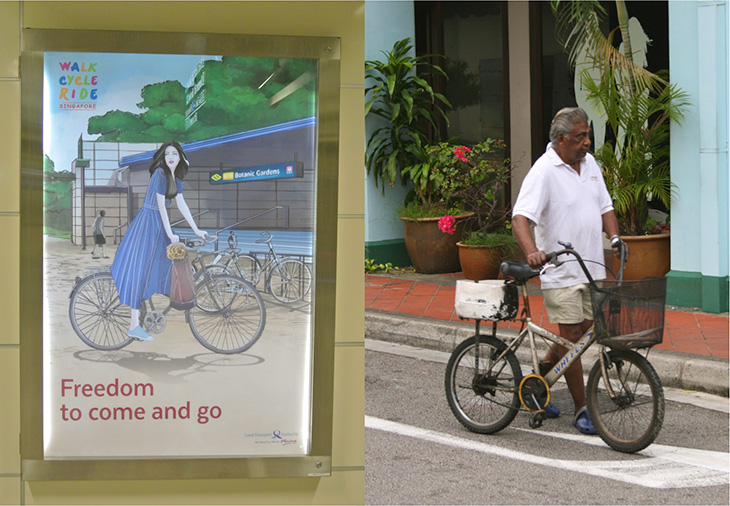
Fiction vs. reality! A romanticized image depicts a Paris-style bicycle commuter on a designer bike riding around an affluent district near the Botanical Gardens (left photo). In contrast, the right photo represents a rather typical public cyclist observed across much parts of Singapore.
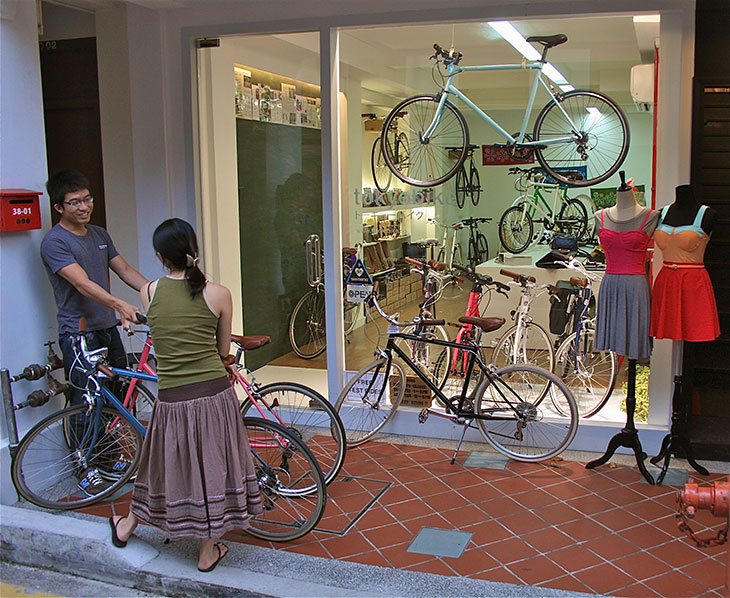
A shop in Kampong Glam, also known as ‘Arab Street’, which has recently been transformed into one of the epicentres of the local hipster subculture.
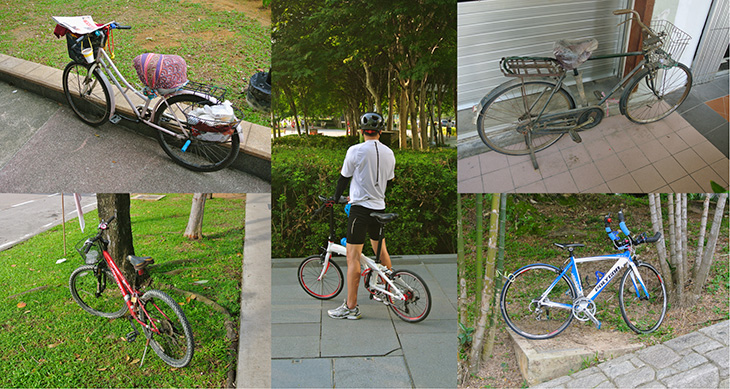
The diversity of bikes observed on roads across the city’s districts represents fairly accurately the socio-economic range of Singapore’s society.

A white-collar worker in the CBD doing some stretching before heading back home on his road bike (left photo). An increasing number of residents who live in the inner-city districts, however, have recently started using electric personal mobility devices (PMD) to commute to workplace (right photo). Could this electric revolution make short- and mid-distance bicycle commuting obsolete in the near future?
As for recreational cycling, its popularity reaches relatively low levels too (not as low as public cycling, though). While HDB-indoor fitness clubs and badminton courts, among other sporting facilities, struggle with increasing demand, large parts of the local bicycle trail network look deserted during much of the day and week. Hence, it is plausible that further expansion of the bicycle trail and bicycle lane network could eventually result in a supply-demand-mismatch – for example, if the cycling participation levels were to stagnate. At present, nearly 4 per cent of Singapore residents go for recreational bike rides at least once a week. Yet this latest official figure includes road cyclists and mountain-bikers (who rarely use paved bike trails or off-road bike lanes). In this regard, the actual figure for Singapore residents who utilize the existing network of bicycle trails and lanes located in city parks, along park connectors and within HDB-Towns, is likely to be somewhere around 2 per cent.
Taken together, it appears somewhat disproportionate and unjustifiable to use a sizeable portion of Singapore’s limited territory for accommodating the fairly low numbers of bicycle commuters and recreational cyclists. This is all the more problematic given that the bicycle path network is likely to be extended to 700km by 2030, according to the government’s recent annual LTA report, potentially resulting in an even greater demand-and-supply imbalance.
>> READ next chapter “Outdoor fitness stations”
